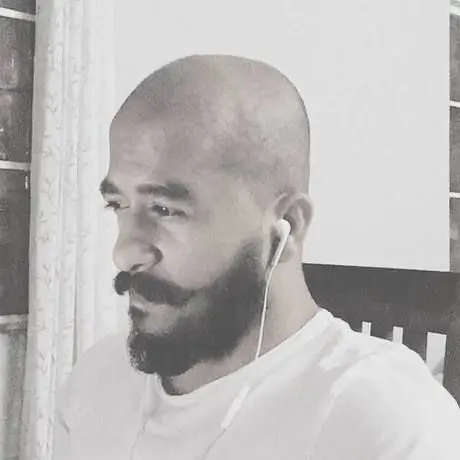Working with a government body to digitise their offline hospital quality assurance system
What’s the problem?
The NRHM (National Rural Health Mission) is an initiative undertaken by the Government of India to address the health needs of under-served rural areas. The NRHM was initially tasked with addressing the health needs of 18 states that had been identified as having weak public health indicators.
In an effort to better this setup, the Government of India setup the NHSRC (National Health Systems Resource Centre), under the NRHM, to serve as an apex body for technical assistance. The goal of this institution is to improve health outcomes by facilitating governance reform, health systems innovations, and improved information sharing among all stakeholders — at the national, state, district and sub-district levels — through capacity development and convergence models.
One of the areas that the NHSRC works in is the provision of universal healthcare services. Universal access to good quality services — services that are effective, that are safe and satisfying to the patient; services that are patient and community centred, and services that make efficient use of the limited resources available.

The approach for achieving these objectives involves ensuring that every single health facility is scored against pre-defined standards with periodic supportive supervision for ensuring continual improvement.
There are three main components to conducting an assessment,
- Facilities
- Assessments themselves, and
- Facilitators
Facilitators conduct Assessments for Facilities.

Facilities are hospitals or other healthcare systems that exist at different levels,
- National level
- State level
- District level
- District Hospital level
Based on their level, facilities would be eligible for a particular type of assessment.
There are two main types of assessments in the system,
- National Quality Assessment System (NQAS): Is a system which has incorporated best practices from the contemporary systems, and contextualised them for meeting the needs of Public Health System in the country
- Kayakalp assessment: To complement the government’s ‘Swachh Bharat Abhiyan’ (cleanliness in public spaces campaign), the Ministry of Health & Family welfare, Government of India launched a National Initiative to present awards to public health facilities that demonstrate high levels of cleanliness, hygiene and infection control
Assessments are a set of pre-defined standards against which facilities are scored. Assessments happen periodically throughout the year under supervision to ensure continual improvement.
Facilitators are people with varied experience, who are picked based on the type of assessment. For instance, National level assessments would require facilitators with a certain set of requirements as compared to a State level assessments. For instance, national level facilitators will consist of representatives from the programme divisions (maternal health, child health, family planning, etc.) of the Ministry of Health and Family Welfare, Government of India and National Health Systems Resource Centre.
How does the assessment process work?
The assessment process requires Facilitators to give a Score (of 0, 1 or 2) to a Measurable Element (ME).
Each ME belongs to an Area of Concern (AoC) and an AoC belongs to a Standard.
Standards: These are broad thematic areas with respect to cleanliness & hygiene, and can be termed as the “pillars” of the system.
Area of Concern: Each theme (Standard), has a fixed number of criteria that cover specific attributes.
Measurable Element: Is the lowest and most tangible unit of an assessment. MEs are specific requirements that the facilitators are expected to look for in a facility for ascertaining the extent of compliance and award a score.
Checkpoints: In the NQAS type assessment, MEs are broken down further into Checkpoints. Checkpoints are departmental checklists.
This is how the above-mentioned elements exist in the Assessments,
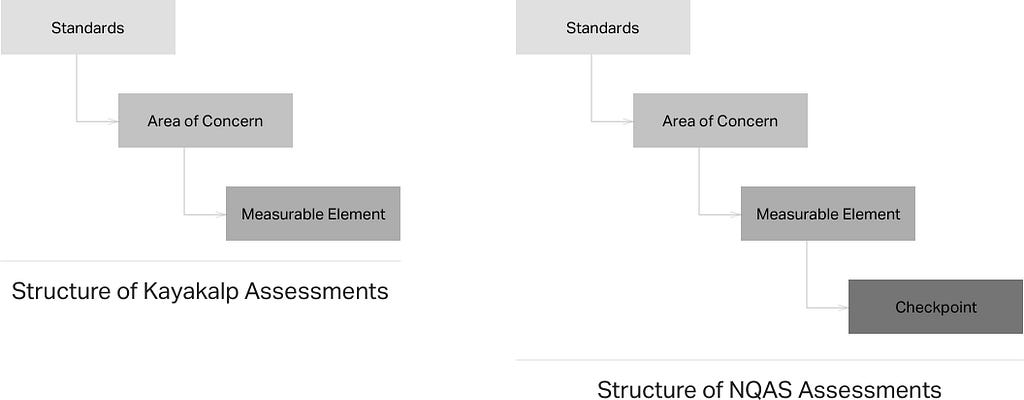
Assessments for Facilities are done via Checklists, which encapsulate all of the above (Standards, AoCs, MEs and Checkpoints).
How were assessments conducted prior to the app?
Facilitators were handed sheets of paper with all the Standards, AoC and ME on them. Facilitators would traverse back and forth through this list, assign a compliance score to a ME until they were done with all AoC and subsequently with all Standards.
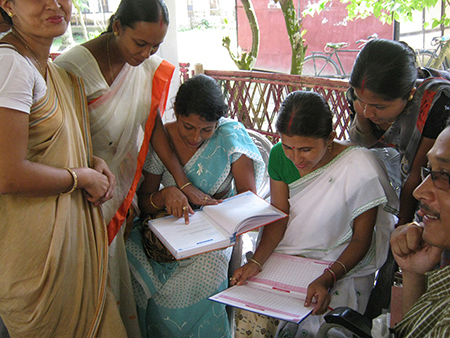
Advantages of the offline system,
- Easy and fast scanning of Standards, AoCs and MEs
- This medium requires little to no training
Disadvantages of the the offline system,
- Hard to keep track of progress. Facilitators have to scan and do this themselves by repeatedly going through the list
- Force facilitators to conduct their assessments by the list, rather than what is convenient
- Unobliging towards writing comments for scores awarded to MEs
- Can’t generate reports immediately
- Submitting Assessments as a physical copy and manually syncing the results across the entire district/state/nation
What is Gunak?
Based on the disadvantages mentioned above, Nikhil (senior member of the NHSRC) thought it’d be best to use technology to make the process of conducting and syncing assessments easier. Gunak is the app that aimed at doing this.
Minimum feature list we aimed to launch the app with,
- Conduct NQAS and Kayakalp assessments
- Motivate facilitators to enter comments for the scores they give
- Allow assessments to be conducted offline
- Sync assessments once facilitators were in an area with active internet connection
- View detailed reports across all Standards, AoCs and MEs for finished assessments
- Sync reports of finished assessments for peers/superiors to view/review
The challenges we faced,
- Maintain familiarity while transitioning facilitators from an offline to an online system
- Translating a multi-tier architecture to mobile
Navigation
Usage: For an assessment to be complete, facilitators have to finish all MEs across all AoCs.
Usage Pattern: Facilitators, physically visit facilities to conduct assessments. The offline medium sometimes forced the facilitators to finish Measurable Elements in a sequential order (as displayed on paper) since it would be easier to keep track of the progress of the assessment.
Notes:
- MEs are specific department-wise questions for a facility. Since most facilities aren’t built the same way, following a sequential pattern wasn’t the way to go ahead.
- The assessments are usually carried out over a period of 3–5 days.
We wanted to design a system that would be flexible and not dictate facilitator behaviour. A system that would always keep the facilitator aware of where they are and their progress. In addition to this, we had to ensure that readability and usability were the main focus since facilitators moved around a lot while conducting assessments.
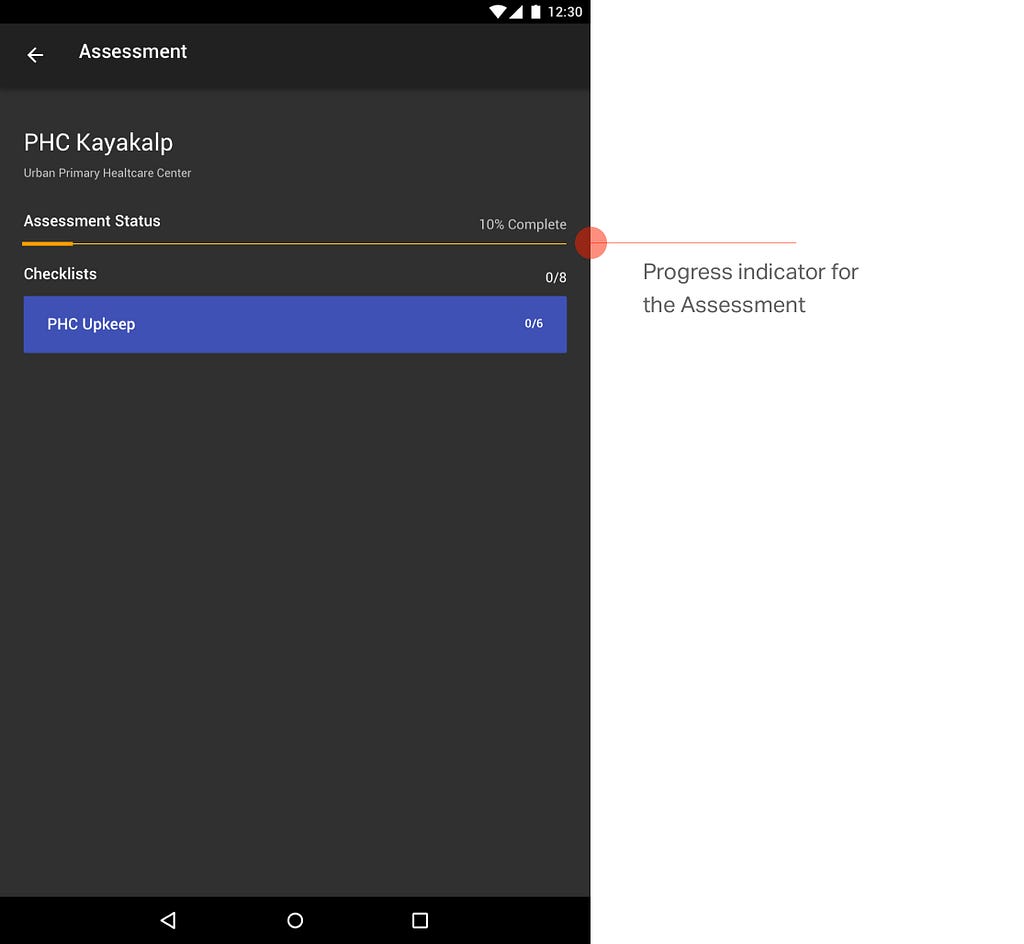

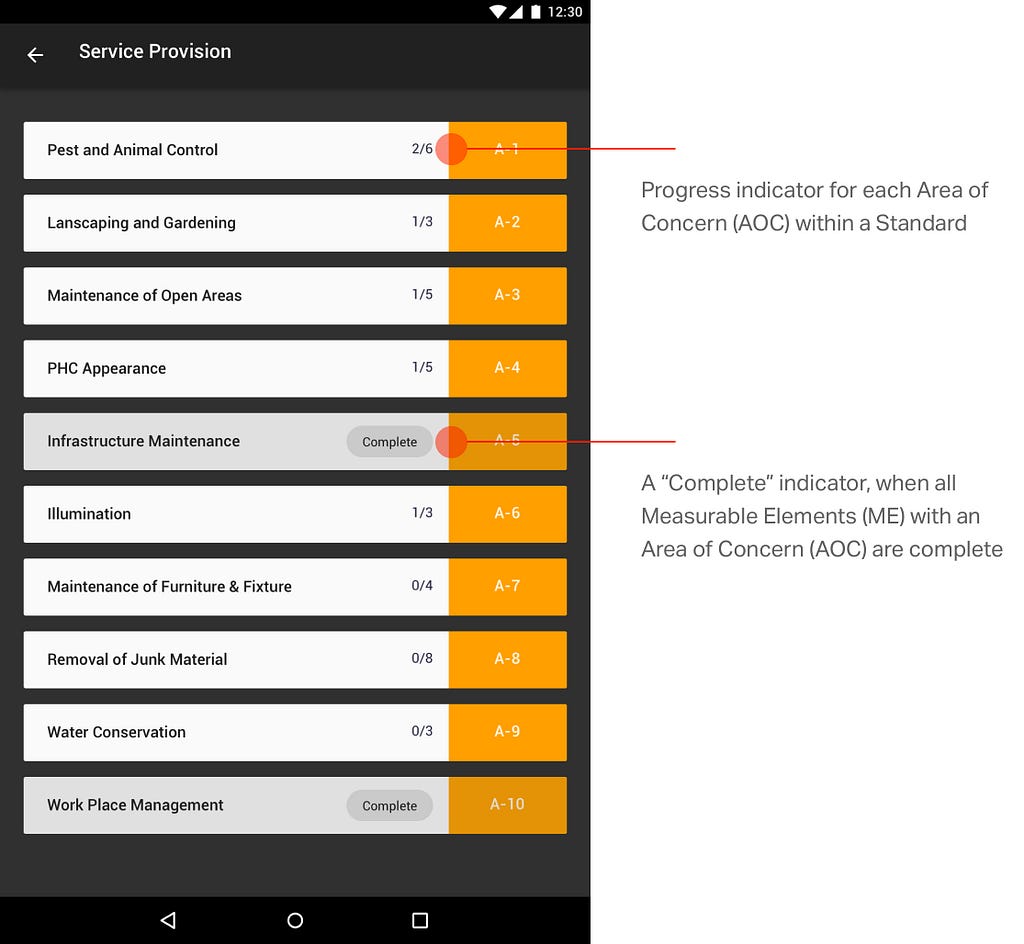
The bottom navigation for an ME, allows facilitators to know the progress of the AoC these MEs belong to. It works as a navigation system where facilitators can jump forward to answer an ME and come back to answer another ME.
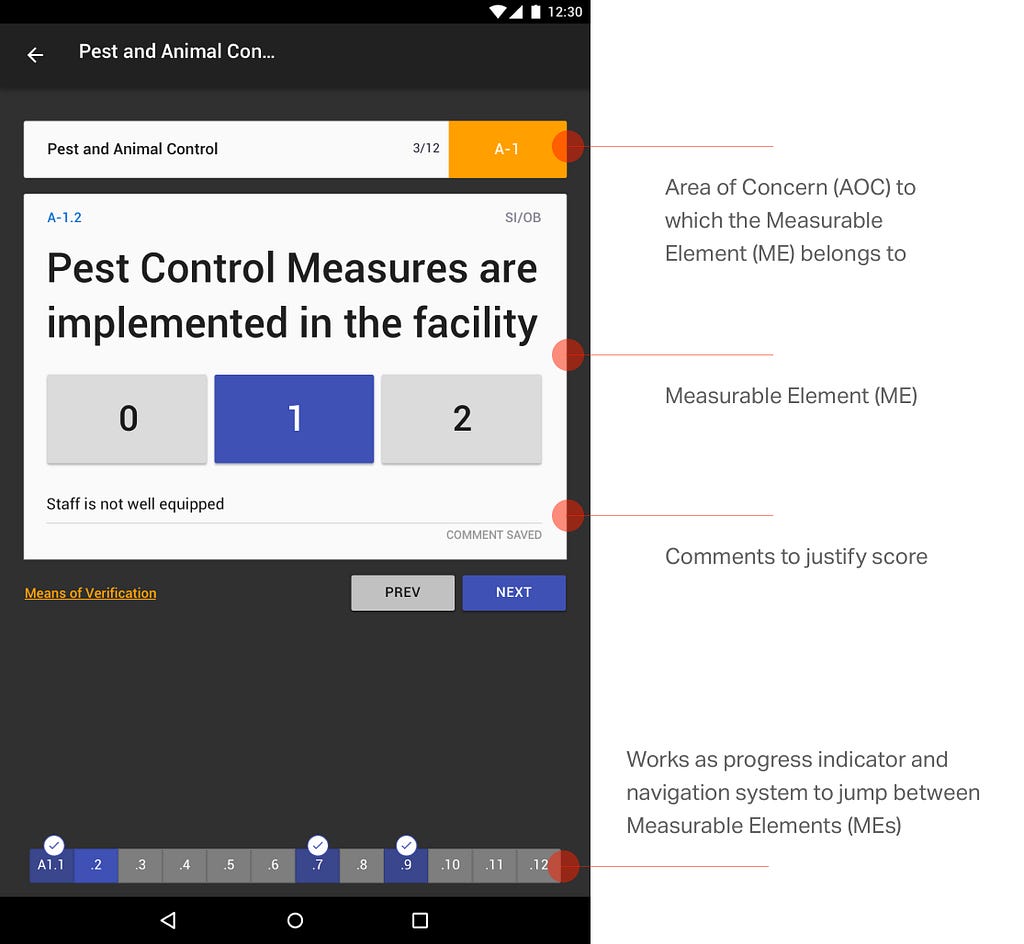
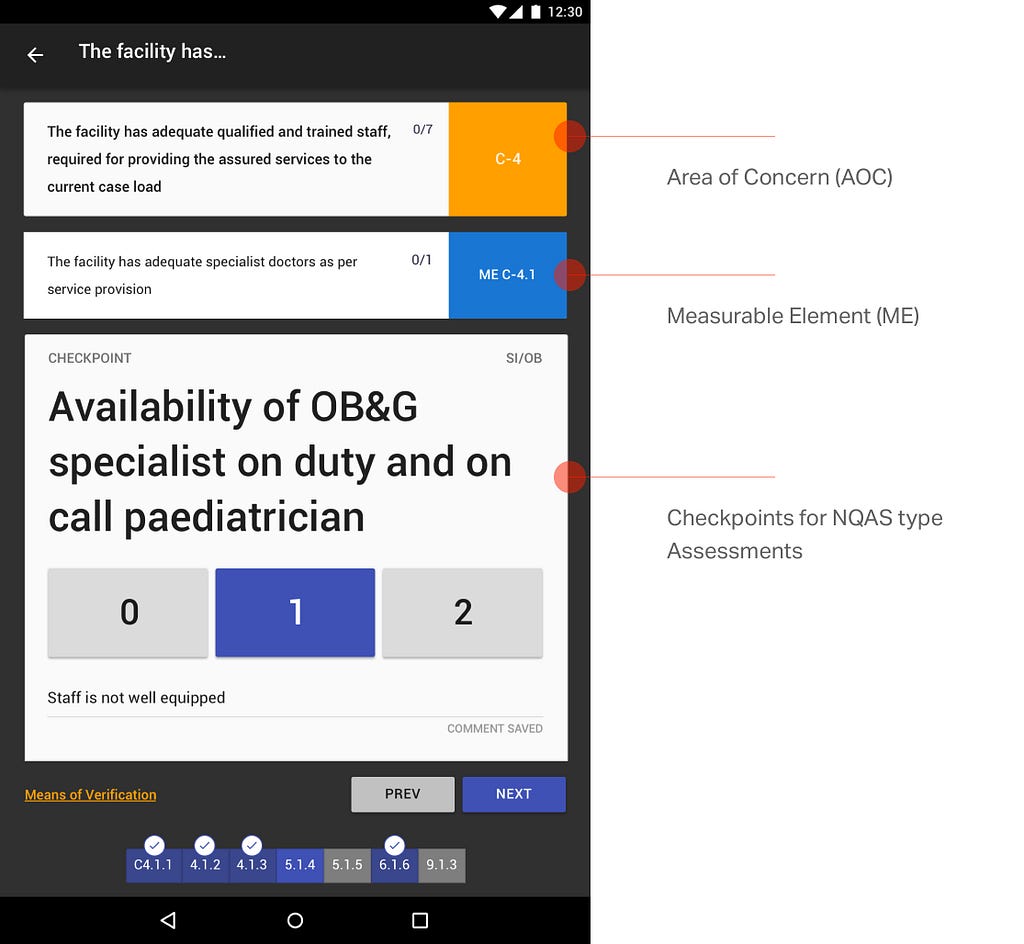
Search
We wanted to find an equivalent for the ‘flip & find’ function, that facilitators perform on paper, for the app.
Search allows facilitators to find MEs, AoCs and Standards.
Our Search feature isn’t a simple text match. As seen below, it can identify that the word ‘hygiene’, could pertain to a Standard, an AoC or MEs.
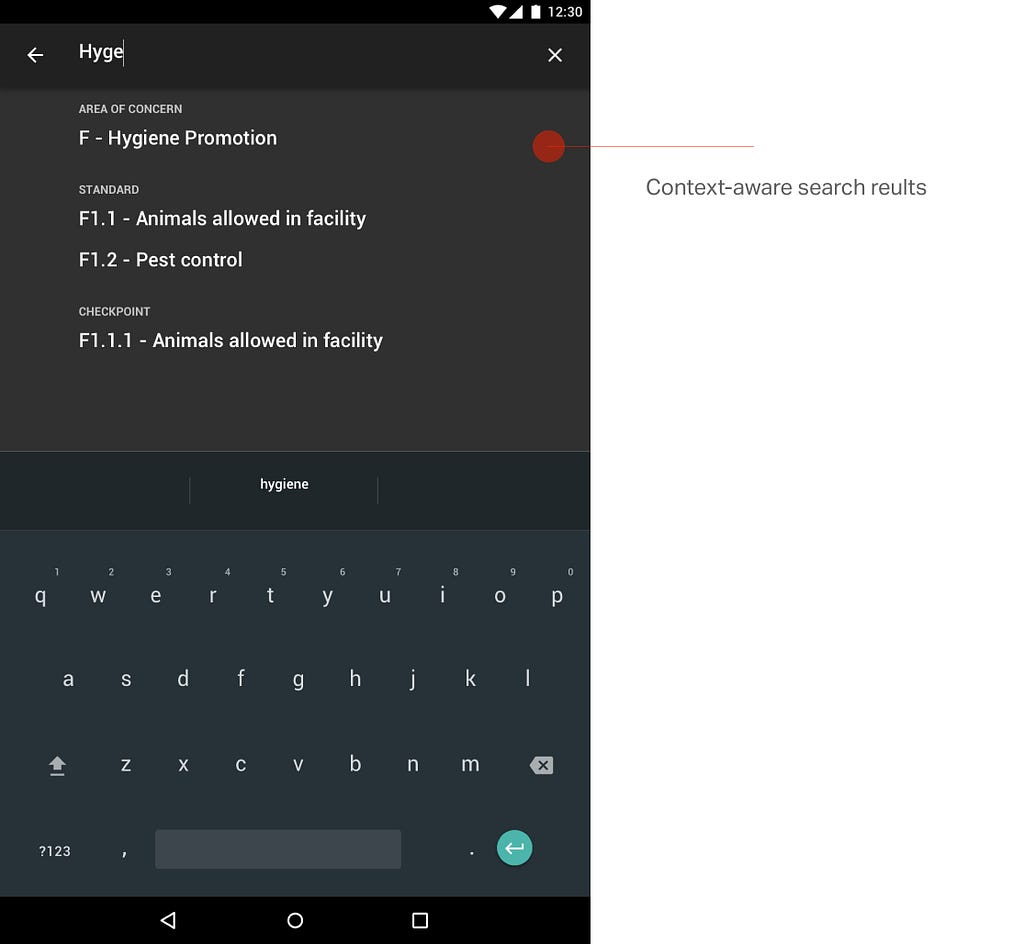
Reports
One of the main drawbacks of the offline medium was its inability to generate reports. A facilitator or their superior would spend hours going through an assessment and assign a score for the same.
We took advantage of technology to provide detailed reports based on Departments, AoC and Score, which can be shared as an excel sheet or as an image.

Who did we work with?
This project would not have been possible if it wasn’t for the amazing team at Samanvay. This is our second project with them, you can read about the first one here,
Designing for Rural India — Part 1
App Launch and Reception
The Gunak app is being rolled out in phases. Its first launch was in August 2017 by the Ministry of Health and Family Welfare, the app has a 4.8* rating on the play store.

Thank you so much for reading this. If you found this interesting, don’t forget to 👏 👏
If you have questions or thoughts about the post and/or would like to reach out to us outside of Medium, send us an email, moshimoshi@nilenso.com
🙏
Gunak — Designing with the Indian Government was originally published in uxdesign.cc on Medium, where people are continuing the conversation by highlighting and responding to this story.
